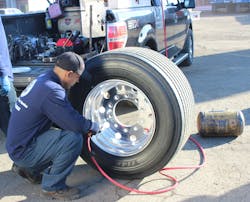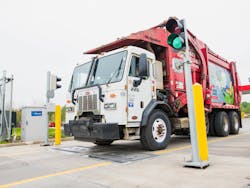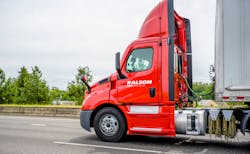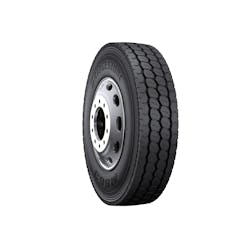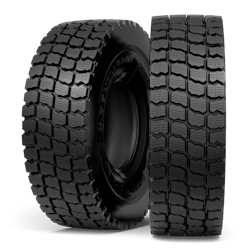Tire makers discuss spec'ing commercial tires by duty cycle
Years ago, spec’ing tires was a lot simpler. Fleet managers would half-jokingly say tires only needed to be “round, black, and have plenty of rubber.” Many of those fleet managers never actually thought one type of tire was much different from another. Size mattered, but price ruled the purchasing decision even more, as tires consume a large portion of a fleet’s parts budget.
Today, the considerations fleets must take into account when spec’ing tires have become much more detailed and complex. Tires are now developed for specific applications, duty cycles, and types of equipment. Tread compounds and designs are crafted for regional, on-highway, local, on/off road, and other types of operations, and for different types of terrain and climates. More recently, they’re being built for specific types of powertrains as well.
Read more: Reduce, Reuse, Recycle: Retreading commercial tiresNot surprisingly, fleets remain mostly secretive about their tire choices and spec’ing practices. In fact, nearly a dozen different operations turned down an invitation from Fleet Maintenance to speak about this subject. Fortunately, though, tire manufacturers are much more receptive, so we asked a number of them to help us out. The Tire Industry Association also chimed in.
The questions we asked were simple and straightforward, ranging from how to match tires to duty cycle to the best ways to measure tire performance.
The respondents included:
- Kevin Rohlwing, Chief Technical Officer, Tire Industry Association
- Matt Schnedler, Senior Product Manager, Truck & Bus Radial, Bridgestone Americas
- Tim Kelly, Original Equipment & National Account Manager, Double Coin
- Tom Lippello, Senior Director, Commercial Marketing, Goodyear North America
- Jim Garrett, Product Category Manager, Michelin North America
- Brian Sheehey, Senior Vice President, Ralson Tire North America
- Tom Clauer, Senior Manager of Commercial Product Planning, Yokohama Tire
Fleet Maintenance: How can fleets best match tires to their equipment and duty cycles?
Kelly: The best thing a fleet can do is to collaborate with their tire manufacturer or dealer to match tires for specific applications. Tire testing is a great way to determine what products can produce the best overall performance and lowest cost per mile.
Lippello: The first step in finding the right tires for your fleet’s duty cycles is understanding the type of vehicle and applications the tire will be used for and deciding which performance features will help you get the job done. Also consider specific operating and underfoot conditions such as load carrying requirements, weather conditions, and environmental considerations.
Rohlwing: Working with local dealers and tire manufacturers can help determine what is working in similar applications. Constantly testing tires and retreads is also helpful, so it’s a good practice to periodically try new tread designs and measure the results.
Schnedler: Fleets should match tires by application and position because they are designed with specific patterns, compounds, and casing configurations. For instance, while there are both linehaul and on/off road drive tires, the linehaul tires will maximize wear and fuel efficiency while on/off road tires will maximize traction and cut/chip resistance.
Sheehey: Fleet executives should review the actual duty cycle for their equipment. Keep in mind that duty cycle is the time the vehicle is used, not the application or the conditions it is operated in. An example of significant operational changes is fleets involved in port transportation. With recent congestion issues and scheduling backups, their vehicles are spending considerably more time waiting than during pre-pandemic operations.
Garrett: Understand that your vehicles, routes, maintenance practices, and company objectives are all crucial factors when choosing the correct tires. Prioritize what is important to your fleet, whether it’s fuel mileage, traction, driver satisfaction, long life, even wear, retreadability, or durability.
Clauer: Know the area where the equipment will be operated. Is it regional or long haul? Is it in northern or southern states? What are the weather conditions, such as snow, wet or dry roads? Will the geography be flat, mountainous, or both? Then there’s weight. Will the vehicles be loaded all the time, or part time? What is the anticipated average loaded weight? All this information can be used to drill down to the right tire for the equipment and the operation.
Summary: It’s all about total cost of ownership. Today, tires are highly engineered components designed to perform specific functions, so matching the right tire to your fleet’s individual needs is the key to getting the performance you require and maximizing your return on investment.
FM: Do the types of powertrains, brake systems, or the use of TPMS/ATIS impact tire specs?
Garrett: Powertrains can have an impact on tire choice. For example, for today’s electric trucks certain tires are designed to manage higher torque. Brake systems and the use of TPMS/ATIS do not have a significant impact on tire selection. However, they can have a major impact on tire performance.
Kelly: Fleets need to consider what works best with all the various technologies that will be employed. It’s always good to get input from your tire manufacturer.
Clauer: Knowing the capabilities/performance of each type of equipment is vital to tire selection. Several years ago, the introduction of low rpm/high-torque diesel engines had a dramatic effect on drive tire selection and that remains a valid concern, including with electric powertrains. Torque values have considerable effect on drive tires, but that can be addressed with proper tire selection.
Lippello: The type of powertrain a fleet uses should be a consideration when deciding what type of tire is needed. When fleets upgrade vehicles, incorporate new services, or transition to EVs, the tires need to change.
Rohlwing: Early reports on tread mileage for electric trucks are not promising, as fleets are experiencing accelerated treadwear on drive axle tires. Manufacturers are working on drive tires for electric drivetrains, but the same mileage as diesel powertrains cannot be expected. TPMS and ATIS won’t have much of an impact on tire specs, but they will extend tire and casing life by limiting the amount of time that the tires operate in an underinflated condition.
Schnedler: While we continue to learn about the differences between internal combustion engine and electric commercial vehicles, there appear to be some differences that can affect tire specs. Two important parameters for tires going on electric vehicles are load capacity, because batteries increase vehicle weight, and low rolling resistance, which will increase range. When considering the impact of TPMS/ATIS, all tires are designed to operate at the proper air pressure, so tire spec selection does not really depend on having the correct air pressure.
Summary: As technology on trucks changes so does the impact on tires. For example, with automated manual transmissions higher torque led to increased heel and toe wear. With EVs, torque values have risen further, leading to even more questions.
FM: How can fleets measure tire performance?
Schnedler: Depending on the fleet, it can be important to measure tread wear life, fuel consumption, or the number of times a tire is retreaded. Measuring performance can get more sophisticated by combining several of these measures into total life cycle cost.
Lippello: When it comes to tire performance, the most important thing to check frequently is tire pressure and treadwear, because those two factors directly influence fuel efficiency, performance, and ultimately, the costs for fleets.
Rohlwing: Cost per mile is a good indicator of performance, and while it’s not a sophisticated formula, it requires attention to regularly check and record tread depth and mileage. In some cases, fuel mileage is also factored into the equation because fuel-efficient tread compounds may save enough to offset tire costs.
Sheehey: There are both active and passive processes available. The simplest method is inspection and review at a certain time interval or during scheduled maintenance. Inspections should also be done at removal for a condition review. An application review needs to be done as well, as your business model may be shifting but your tire spec hasn’t changed.
Clauer: Utilize tools that can track miles, identify developing conditions, calculate miles per 32nd, and help make selection choices to minimize cost and maximize efficiencies.
Kelly: Most fleets use cost per mile or cost of ownership to ensure they are maximizing their tire use. Recording installation mileage and periodic checks to track tire performance of different tread designs and manufacturers is important.
Garrett: Look at measurables that match your priorities such as fuel mileage, driver feedback, removal mileage, retreadability, and roadside events. Some of these are more difficult to measure, but putting a little extra effort in will always pay off.
Summary: Depending on the performance metric a fleet wants to measure, testing can be done in-house for things like tread life. Most important for a fleet is to manage by the averages. Measurements like cost per 32nd, for example, can help keep comparisons simple and level the playing field between tire brands and models.
FM: What best practices for tire spec’ing can you recommend?
Schnedler: Begin by first determining the most important parameter for your fleet, whether it be fuel efficiency, wear, traction, etc. Then refer to the application guides provided by the tire manufacturer to select the appropriate tire to meet those requirements.
Garrett: One of the most important things to look for is if the tires match the truck OEM’s recommendations in terms of size, load, and speed rating. Also, be sure you are using the right wheel size. While the tires that come on your vehicle from the OEM will work, they may not be properly optimized for your particular operation. It is suggested you contact your tire dealer or tire manufacturer representative. They will be truly knowledgeable concerning items to consider when matching tires with vehicles.
Kelly: Understanding your business, what has worked in the past and asking a lot of questions to find out what specific routes, road surfaces, and loads you run are all important to know in order to find the right tire for a specific application.
Clauer: Work with the equipment manufacturer to understand the performance values of your equipment. Reach out to a tire professional to help match the right tire to maximize the equipment and load for the operational/geographical area this equipment will be used in.
Lippello: There are a number of best practices that fleet owners can implement to ensure optimal tire performance and save on costs. The first step to ensuring you’re selecting the right tires for your fleet, whether it’s off-the-road, mixed service, long haul, or another application, is to understand the types of products that will work best and will ultimately play a significant role in driving down overall tire costs.
Application aside, consider specific operating conditions such as load carrying requirements, weather conditions or environmental inputs. If you’re not sure which tires are right for your fleet, commercial tire manufacturers and dealers can assist in finding the right tires.
Sheehey: The best practice for tire spec’ing is to get information from and involvement with your manufacturer and dealer representative. To maximize your tire spec results, it is important to review all current brand offerings and ask for information or demonstrations. They can provide common sense solutions based on data and improved technology for enhanced performance, increased longevity, and reduced tire lifecycle costs. The only requirement from the fleet is an open mind and a willingness to share past and current experience and discuss future needs.
Summary: Expert advice is valuable in all areas of fleet management, and especially for items like tires, which continue to constitute a high cost area for fleets. One common piece of advice for fleets is simple—ask the experts.
The Bottom Line
For all manufacturers, their advice for maximizing the value of the tires centers on considering all the variables. And that goes beyond the operational considerations they have already discussed and even the proven performance of their current and expanding product offerings.
Other suggestions, for example, include asking tire dealer or manufacturer representatives to meet with the capital decision makers in your fleet as well as the maintenance managers at your company to provide a holistic review of your assets’ tire needs.
Manufacturers also universally agree that effective tire management and maintenance programs are absolutely essential for achieving long tire lifecycles. For example, when it comes to tire performance, the most important things to check frequently are tire pressure and treadwear since those two factors directly influence fuel efficiency, performance and ultimately, overall tire costs for fleets.
Once a fleet has outfitted their vehicles with the tires that best suit their needs, the manufacturers added, it is highly recommended to implement a comprehensive tire management program to reduce cost, prolong vehicle uptime, and maximize the return on your fleet’s tire investment.
About the Author

Seth Skydel
Seth Skydel, a veteran industry editor, has more than 36 years of experience in fleet management, trucking, and transportation and logistics publications. Today, in editorial and marketing roles, he writes about fleet, service, and transportation management, vehicle and information technology, and industry trends and issues.

